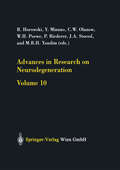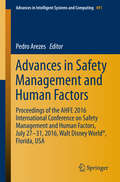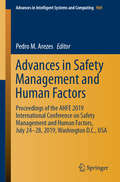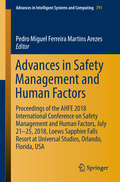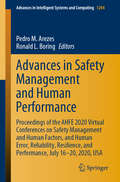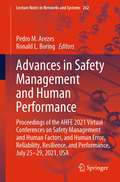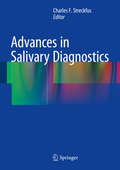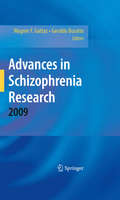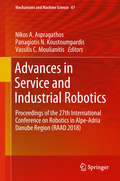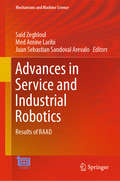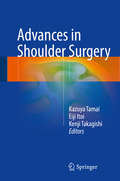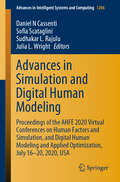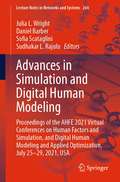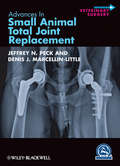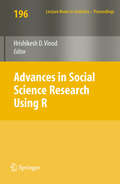- Table View
- List View
Advances in Research on Neurodegeneration: Volume 10 (Journal of Neural Transmission. Supplementa #65)
by Dr R. Horowski Prof. Y. Mizuno Prof. C. W. Olanow Prof. W. H. Poewe Prof. P. Riederer Dr J. A. Stoessl Prof. M. B. H. YoudimAdvances in Research on Neurodegeneration: Volume 5 (Journal of Neural Transmission. Supplementa #50)
by P. Riederer, D. B. Calne, R. Horowski, Y. Mizuno, W. Poewe and M. B. H. YoudimVolume 5 of the series "Advances in Research on Neurodegeneration" is concerned with themes which are currently the focus of intensive research, and in which advances in our understanding of the pathological mechanisms un derlying neurodegenerative diseases are expected in the near future. The first section contains five reviews devoted to the various neuroimaging technolo gies. The discussion is concerned with the question of whether neuroimaging techniques make it possible to follow the process of degeneration as it occurs, and which methods offer the required sensitivity and quantifiability for this purpose. However, the question needs to be examined of whether, given the physical and chemical limitations of these techniques, even under optimal conditions, anatomical resolution can be improved to the extent that neuro degenerative diseases can be diagnosed earlier than currently possible and a confident diagnosis made. The possibilities of using neuroimaging techniques to provide information regarding the effects of neuroprotective or neuroregen erative therapeutic strategies, and for correlating the results of neuropsycho logical research with imaging data are also discussed. The second section is concerned with the significance of endogenous or exogenous neurotoxins as triggers for neurodegenerative processes that may lead to Parkinsonism. Vulnerability factors, which include such factors as nerve ending sensitivity, the synergistic effects of drugs and the various mechanisms underlying different toxins are discussed.
Advances in Research on Neurodegeneration (Journal of Neural Transmission. Supplementa)
by Prof. Dr. P. Riederer Prof. Dr. D. B. Calne Dr R. Horowski Prof. Dr. Y. Mizuno Prof. Dr. C. W. Olanow Prof. Dr. W. Poewe Prof. Dr. M. B. H. YoudimAdvances in Research on Neurodegeneration: Volume 6 (Journal of Neural Transmission. Supplementa #55)
by G. Ransmayr W. PoeweAdvances in Research on Neurodegeneration: 3 & 4 (Journal of Neural Transmission. Supplementa #49)
by P. Riederer W. Poewe R. Horowski D. B. Calne M. B. H.Youdim Y. MizunoNeurodegeneration is one of the most important subjects of the investigation now and in the coming 21st century. Alzheimer's disease is the leading cause of dementia in the elderly people and Parkinson's disease is one of the major neurologic disorders with the prevalence between 1 and 2/1 000 population in advanced countries. Many others are suffering from intractable neurodegener ative disorders such as amyotrophic lateral sclerosis, Huntington's disease, or spinocerebellar degeneration. No truly effective treatment is available for any of these neurodegenerative disorders except for Parkinson's disease; even in Parkinson's disease, still it is impossible to slow down the disease process with the currently available treatment. It is urgently needed to develop new effective technique to halt or slow down the disease process in each of those disorders. Recent advance in the molecular biological and molecular genetic technique has brought us great progress in the understanding of etiology and pathogenesis of these disorders, but still it is not known how neurons are going to die in these disorders. To explore the question, mutual cooperation and exchange of ideas between basic scientists and clinical peoples are of utmost importance.
Advances in Research on Neurodegeneration: Volume 7
by Y. Mizuno, D. B. Calne, R. Horowski, W. Poewe, P. Riederer and M. B. H. YoudimWe organized the Seventh International Winter Conference on Neurodegeneration and Neuroinflammation in a small town of Karuizawa in Nagano Prefecture in Japan on January 20 to 22, 1999. Karuizawa is a nice summer as well as winter resort close to the place for winter Olympic game in the year of 1998. Over 40 scientists gathered together and made hot discussion. Neurodegeneration and neuroinflammation are two major and important neurologic disorders, in which satisfactory neuroprotective and neurorestorative treatment is not available yet. For this purpose, understanding of molecular mechanisms of neuronal cell death in these two disorders is imperative. Recently, pathologic processes common to these two groups of disorders have been identified such as the involvement of inflammatory changes, microglia, cytokines, and apoptosis. We intended to involve scientists working in these two major fields together to participate in hot and fruitful discussion for the understanding of neuronal death and for developing newer methods of treatment. The science is progressing so rapidly today and we are working in a very narrow specialized area. Sometimes, we are ignorant about important discoveries in other fields. This conference was a nice opportunity for scien tists working different areas to meet together and to exchange their experi ence. This volume is the proceedings of this Winter Conference.
Advances in Respiratory Cancerogenesis (Advances in Experimental Medicine and Biology #911)
by Mieczyslaw PokorskiLung cancer is the leading cause of mortality worldwide, with a low survival rate. Carcinogenesis generally requires a constellation of entwined steps, involving both innate cellular and environmental factors. This book shares the updated knowledge on the origin and development of cancer through genotypic changes which upset the physiological balance between cell proliferation, differentiation, growth control, and apoptosis. The emphasis is put on the role of microRNA proteins involved in the cellular processes above outlined. Cognitive changes, related to dysregulated cellular mechanisms in cancer cells, as yet unchartered area of research, also are tackled. A better understanding of the molecular and cellular biology of lung cancer is the key source of breakthroughs in the diagnosis and prognosis, and finding more effective therapies that target specific mutations. The book provides a source of current facts and trends in clinical research and practice. It will be of interest to clinicians, researchers, and other medical professionals.
Advances in Robot Control: From Everyday Physics to Human-Like Movements
by Sadao Kawamura Mikhail SvininThis volume surveys three decades of modern robot control theory and describes how the work of Suguru Arimoto shaped its development. Twelve survey articles written by experts associated with Suguru Arimoto at various stages in his career treat the subject comprehensively. This book provides an important reference for graduate students and researchers, as well as for mathematicians, engineers and scientists whose work involves robot control theory.
Advances in Safety Management and Human Factors: Proceedings of the AHFE 2017 International Conference on Safety Management and Human Factors, July 17–21, 2017, The Westin Bonaventure Hotel, Los Angeles, California, USA (Advances in Intelligent Systems and Computing #604)
by Pedro ArezesThis book discusses the latest findings on ensuring employees’ safety, health, and welfare at work. It combines a range of disciplines – e.g. work physiology, health informatics, safety engineering, workplace design, injury prevention, and occupational psychology – and presents new strategies for safety management, including accident prevention methods such as performance testing and participatory ergonomics. The book, which is based on the AHFE 2017 International Conference on Safety Management and Human Factors, held on July 17–21, 2017, in Los Angeles, California, USA, provides readers, including decision makers, professional ergonomists and program managers in government and public authorities, with a timely snapshot of the state of the art in the field of safety, health, and welfare management. It also addresses agencies such as the Occupational Safety and Health Administration (OSHA) and the National Institute for Occupational Safety and Health (NIOSH), as well as other professionals dealing with occupational safety and health.
Advances in Safety Management and Human Factors: Proceedings of the AHFE 2016 International Conference on Safety Management and Human Factors , July 27-31, 2016, Walt Disney World®, Florida, USA (Advances in Intelligent Systems and Computing #491)
by Pedro ArezesThis book discusses the latest findings towards ensuring people’s safety, health, and welfare at work. It crosses different disciplines, such as work physiology, health informatics, workplace design, injury prevention, and occupational psychology. It presents new strategies for safety management, including accident prevention methods, such as performance testing and participatory ergonomics. The book, which is based on the AHFE 2016 International Conference on Safety Management and Human Factors, held on July 27-31, 2016, in Walt Disney World®, Florida, USA, provides readers, including decision makers in government and public authorities, with a timely snapshot of the state of the art in the field of safety, health and welfare management. It also addresses agencies such as OSHA and NIOSH as well as other professionals dealing with occupational safety and health.
Advances in Safety Management and Human Factors: Proceedings of the AHFE 2019 International Conference on Safety Management and Human Factors, July 24-28, 2019, Washington D.C., USA (Advances in Intelligent Systems and Computing #969)
by Pedro M. ArezesThis book discusses the latest findings on ensuring employees’ safety, health, and welfare at work. It combines a range of disciplines – e.g. work physiology, health informatics, safety engineering, workplace design, injury prevention, and occupational psychology – and presents new strategies for safety management, including accident prevention methods such as performance testing and participatory ergonomics. The book, which is based on the AHFE 2019 International Conference on Safety Management and Human Factors, held on July 24-28, 2019, Washington D.C., USA, provides readers, including decision makers, professional ergonomists and program managers in government and public authorities, with a timely snapshot of the state of the art in the field of safety, health, and welfare management. It also addresses agencies such as the Occupational Safety and Health Administration (OSHA) and the National Institute for Occupational Safety and Health (NIOSH), as well as other professionals dealing with occupational safety and health.
Advances in Safety Management and Human Factors: Proceedings of the AHFE 2018 International Conference on Safety Management and Human Factors, July 21-25, 2018, Loews Sapphire Falls Resort at Universal Studios, Orlando, Florida, USA (Advances in Intelligent Systems and Computing #791)
by Pedro Miguel ArezesThis book discusses the latest findings on ensuring employees’ safety, health, and welfare at work. It combines a range of disciplines – e.g. work physiology, health informatics, safety engineering, workplace design, injury prevention, and occupational psychology – and presents new strategies for safety management, including accident prevention methods such as performance testing and participatory ergonomics. The book, which is based on the AHFE 2018 International Conference on Safety Management and Human Factors, held on July 21–25, 2018, in Orlando, Florida, USA, provides readers, including decision makers, professional ergonomists and program managers in government and public authorities, with a timely snapshot of the state of the art in the field of safety, health, and welfare management. It also addresses agencies such as the Occupational Safety and Health Administration (OSHA) and the National Institute for Occupational Safety and Health (NIOSH), as well as other professionals dealing with occupational safety and health.
Advances in Safety Management and Human Performance: Proceedings of the AHFE 2020 Virtual Conferences on Safety Management and Human Factors, and Human Error, Reliability, Resilience, and Performance, July 16-20, 2020, USA (Advances in Intelligent Systems and Computing #1204)
by Pedro M. Arezes Ronald L. BoringThis book brings together studies broadly addressing human error and safety management from the perspectives of various disciplines, and shares the latest findings on ensuring employees’ safety, health, and welfare at work. It combines a diverse range of disciplines – e.g. work physiology, health informatics, safety engineering, workplace design, injury prevention, and occupational psychology – and presents new strategies for safety management, including accident prevention methods such as performance testing and participatory ergonomics. It reports on cutting-edge methods and findings concerning safety-critical systems, defense, and security, and discusses advanced topics regarding human performance, human variability, and reliability analysis; medical, driver and pilot error, as well as automation error; and cognitive modeling of human error. Further, it highlights cutting-edge applications in safety management, defense, security, transportation, process controls, and medicine. Gathering the proceedings of the AHFE 2020 International Conference on Safety Management and Human Factors and the AHFE 2020 Virtual Conference on Human Error, Reliability, Resilience, and Performance, held on July 16–20, 2020, USA, the book offers an extensive, timely, and multidisciplinary guide for researchers and practitioners dealing with safety management and human error.
Advances in Safety Management and Human Performance: Proceedings of the AHFE 2021 Virtual Conferences on Safety Management and Human Factors, and Human Error, Reliability, Resilience, and Performance, July 25-29, 2021, USA (Lecture Notes in Networks and Systems #262)
by Pedro M. Arezes Ronald L. BoringThis book provides readers with a timely snapshot of research and developments relating to human reliability, performance and safety analysis, and human error, risk and safety management in various industrial contexts, such as manufacturing, transportation and health. It combines a diverse range of disciplines, including work physiology, health informatics, safety engineering, workplace design, injury prevention, and occupational psychology, and presents new strategies for safety management, accident prevention at the workplace, performance testing and participatory ergonomics. It discusses issues related to automation, and strategies for a safer Human-Automation Interaction. Based on the proceedings of the AHFE 2021 International Conferences on Safety Management and Human Factors, and Human Error, Reliability, Resilience, and Performance, which were held virtually on July 25-29, 2021, from USA, the book offers an extensive and inspiring guide for both researchers and practitioners dealing with the topics of safety management, human error prevention, and integration of automation in the workplace.
Advances in Salivary Diagnostics
by Charles F. StreckfusThis book reviews the progress made in salivary diagnostics during the past two decades and identifies the likely direction of future endeavors. After an introductory section describing the histological and anatomical features of the salivary glands and salivary function, salivary collection devices and diagnostic platforms are reviewed. The field of “salivaomics” is then considered in detail, covering, for example, proteomics, the peptidome, DNA and RNA analysis, biomarkers, and methods for biomarker discovery. Salivary diagnostics for oral and systemic diseases are thoroughly discussed, and the role of salivary gland tissue engineering for future diagnostics is explored. The book closes by considering legal issues and barriers to salivary diagnostic development. Advances in Salivary Diagnostics will be an informative and stimulating reference for both practitioners and students.
Advances in Schizophrenia Research 2009
by Wagner F. Gattaz Geraldo BusattoSchizophrenia remains an important challenge to psychiatry, with its causes and underlying brain mechanisms yet to be fully revealed. Currently available treatments are neither universally effective nor without unwanted effects. These aspects, together with the high prevalence of schizophrenia, its often debilitating nature, and the associated family and social burden, make this mental disorder one of the most complex public health issues of our times. The purpose of the Advances in Schizophrenia Research series is to provide comprehensive periodic reviews of the wide range of research studies carried out around the world, with the dual purpose of solving the schizophrenia puzzle, and providing clues to new forms of treatment and prevention for this disorder. A special feature of the series is its broad scope, virtually encompassing all fields of schizophrenia research: epidemiology and risk factors; psychopathology; diagnostic boundaries; cognition; outcome and prognosis; pathophysiology; genetics; pharmacological and psychological forms of treatment and rehabilitation; community care; and stigmatization.
Advances in Service and Industrial Robotics: Proceedings of the 27th International Conference on Robotics in Alpe-Adria Danube Region (RAAD 2018) (Mechanisms and Machine Science #67)
by Nikos A. Aspragathos Panagiotis N. Koustoumpardis Vassilis C. MoulianitisThis volume contains the proceedings of the RAAD 2018 conference, covering major areas of research and development in robotics. It provides an overview on the advances in robotics, more specifically in novel design and applications of robotic systems; dexterous grasping, handling and intelligent manipulation; intelligent cooperating and service robots; advanced robot control; human-robot interfaces; robot vision systems and visual serving techniques; mobile robots; humanoid and walking robots; field and agricultural robotics; bio-inspired and swarm robotic systems; developments towards micro and nano-scale robots; aerial, underwater and spatial robots; robot integration in holonic manufacturing; personal robots for ambient assisted living; medical robots and bionic prostheses; intelligent information technologies for cognitive robots etc. The primary audience of the work are researchers as well as engineers in robotics and mechatronics.
Advances in Service and Industrial Robotics: Results of RAAD (Mechanisms and Machine Science #84)
by Saïd Zeghloul Med Amine Laribi Juan Sebastian Sandoval ArevaloThis book gathers contributions by researchers from several countries on all major areas of robotic research, development and innovation, as well as new applications and current trends. The topics covered include: novel designs and applications of robotic systems, intelligent cooperating and service robots, advanced robot control, human-robot interfaces, robot vision systems, mobile robots, humanoid and walking robots, bio-inspired and swarm robotic systems, aerial, underwater and spatial robots, robots for ambient assisted living, medical robots and bionic prostheses, cognitive robots, cloud robotics, ethical and social issues in robotics, etc. Given its scope, the book offers a source of information and inspiration for researchers seeking to improve their work and gather new ideas for future developments. The contents reflect the outcomes of the activities of RAAD (International Conference on Robotics in Alpe-Adria-Danube Region) in 2020.
Advances in Shoulder Surgery
by Kazuya Tamai Eiji Itoi Kenji TakagishiWith critical insights into anatomy and the latest science and research underlying pathogenesis, this book serves as a practical and richly illustrated step-by-step comprehensive guide to successfully performing shoulder surgery, and other related procedures. Abundant diagnostic and treatment approaches including arthroscopy are provided, and are intended to assist beginning and experienced orthopedic surgeons to further develop their skills and facilitate the management of patients with both acute and chronic shoulder injuries. The book provides full-color photos and diagrams to clearly demonstrate operative techniques and tools for surgery. Edited and written by pioneering researcher and surgeons, Advances in Shoulder Surgery offers a valuable guide to recent advances in shoulder surgery and treatment.
Advances in Simulation and Digital Human Modeling: Proceedings of the AHFE 2020 Virtual Conferences on Human Factors and Simulation, and Digital Human Modeling and Applied Optimization, July 16-20, 2020, USA (Advances in Intelligent Systems and Computing #1206)
by Daniel N Cassenti Sofia Scataglini Sudhakar L. Rajulu Julia L. WrightThis book presents the latest advances in modeling and simulation for human factors research. It reports on cutting-edge simulators such as virtual and augmented reality, multisensory environments, and modeling and simulation methods used in various applications, including surgery, military operations, occupational safety, sports training, education, transportation and robotics. Based on two AHFE 2020 Virtual Conferences such as the AHFE 2020 Virtual Conference on Human Factors and Simulation and the AHFE 2020 Virtual Conference on Digital Human Modeling and Applied Optimization, held on July 16–20, 2020, the book serves as a timely reference guide for researchers and practitioners developing new modeling and simulation tools for analyzing or improving human performance. It also offers a unique resource for modelers seeking insights into human factors research and more feasible and reliable computational tools to foster advances in this exciting field.
Advances in Simulation and Digital Human Modeling: Proceedings of the AHFE 2021 Virtual Conferences on Human Factors and Simulation, and Digital Human Modeling and Applied Optimization, July 25-29, 2021, USA (Lecture Notes in Networks and Systems #264)
by Julia L. Wright Daniel Barber Sofia Scataglini Sudhakar L. RajuluThis book provides readers with a timely snapshot of modeling and simulation tools, including virtual and mixed-reality environment, for human factors research. It covers applications in healthcare and physical ergonomics, military and transportation systems, industrial monitoring, as well as economics and social sciences. Based on the AHFE 2021 International Conference on Human Factors and Simulation and the AHFE 2021 International Conference on Digital Human Modeling and Applied Optimization, held virtually on 25–29 July, 2021, from USA, the book offers a unique resource for modelling and simulation researchers seeking insights into human factors research and to human factors experts seeking reliable computational tools.
Advances in Small Animal Total Joint Replacement (AVS Advances in Veterinary Surgery #6)
by Jeffrey N. Peck Denis J. Marcellin-LittleAdvances in Small Animal Total Joint Replacement provides an up-to-date, comprehensive examination of joint replacement in veterinary surgery. Part of the Advances in Veterinary Surgery series copublished with the ACVS Foundation, the book presents an evidence-based, multi-system examination of the current state of hip, knee, and elbow replacement in dogs and cats, including information on biomechanics and biomaterials not found in other sources. Written by an international group of experts, the book offers guidance on the history, indications, contraindications, clinical procedures, and a review of the current literature for these surgical techniques. Focusing on replacement of the hip, knee, and elbow, the book also covers disc, shoulder, carpus, and tarsus replacement, as well as information on the development of custom prostheses. Each section incorporates information on potential complications and outcomes assessment. Advances in Small Animal Total Joint Replacement is an unparalleled repository of information for veterinary surgeons, residents, and practitioners with an interest in these procedures.
Advances in Small Animal Total Joint Replacement (AVS Advances in Veterinary Surgery #5)
by Jeffrey N. Peck Denis J. Marcellin-LittleAdvances in Small Animal Total Joint Replacement provides an up-to-date, comprehensive examination of joint replacement in veterinary surgery. Part of the Advances in Veterinary Surgery series copublished with the ACVS Foundation, the book presents an evidence-based, multi-system examination of the current state of hip, knee, and elbow replacement in dogs and cats, including information on biomechanics and biomaterials not found in other sources. Written by an international group of experts, the book offers guidance on the history, indications, contraindications, clinical procedures, and a review of the current literature for these surgical techniques. Focusing on replacement of the hip, knee, and elbow, the book also covers disc, shoulder, carpus, and tarsus replacement, as well as information on the development of custom prostheses. Each section incorporates information on potential complications and outcomes assessment. Advances in Small Animal Total Joint Replacement is an unparalleled repository of information for veterinary surgeons, residents, and practitioners with an interest in these procedures.
Advances in Smart Healthcare Paradigms and Applications: Outstanding Women in Healthcare—Volume 1 (Intelligent Systems Reference Library #244)
by Halina Kwaśnicka Nikhil Jain Urszula Markowska-Kaczmar Chee Peng Lim Lakhmi C. JainThis book is dedicated to showcase research and innovation in smart healthcare systems and technologies led by women scientists, researchers, and practitioners. With the advent of artificial intelligence (AI) and related technologies, the healthcare sector has undergone tremendous changes in practice and management in recent years. On par to men, women have made significant contributions to tackle a variety of healthcare problems, creating smarter paradigms to provide effective and efficient solutions for patients and stakeholders. The book presents a small collection of contributions by outstanding women in STEM (Science, Technology, Engineering and Mathematics) education, focusing on the healthcare domain. The selected articles allow readers to comprehend current advances in AI and other methods for undertaking healthcare challenges. It is envisaged that the inspiring work by prominent women scientists, researchers, and practitioners reported in this book offers a beacon to propel women in pursuing STEM education and advancing the healthcare sector for the benefits of humankind.
Advances in Social Science Research Using R (Lecture Notes in Statistics #196)
by Hrishikesh D. VinodQuantitative social science research has been expanding due to the ava- ability of computers and data over the past few decades. Yet the textbooks and supplements for researchers do not adequately highlight the revolution created by the R software [2] and graphics system. R is fast becoming the l- gua franca of quantitative research with some 2000 free specialized packages, where the latest versions can be downloaded in seconds. Many packages such as “car” [1] developed by social scientists are popular among all scientists. An early 2009 article [3] in the New York Times notes that statisticians, engineers and scientists without computer programming skills ?nd R “easy to use.” A common language R can readily promote deeper mutual respect and understanding of unique problems facing quantitative work in various social sciences. Often the solutions developed in one ?eld can be extended and used in many ?elds. This book promotes just such exchange of ideas across many social sciences. Since Springer has played a leadership role in promoting R, we are fortunate to have Springer publish this book. A Conference on Quantitative Social Science Research Using R was held in New York City at the Lincoln Center campus of Fordham University, June 18–19, 2009. This book contains selected papers presented at the conference, representing the “Proceedings” of the conference.
